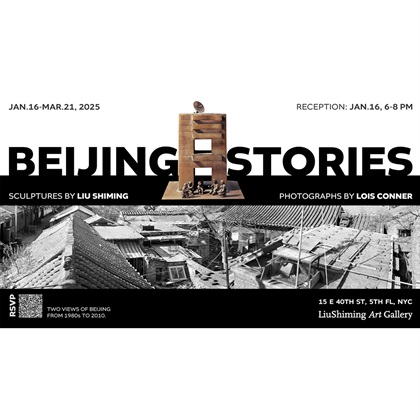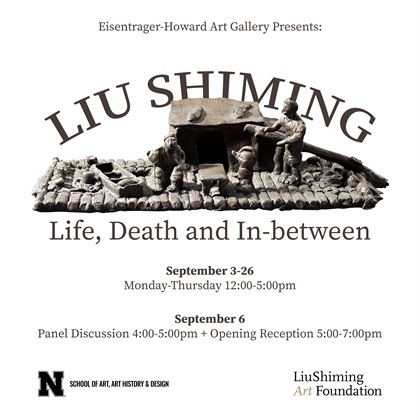
“Liu Shiming: Life, Death and In-between,” a mini retrospective of the artist's work, will be on view in the Eisentrager Howard Gallery in Richards Hall from Sept. 3-26.
A panel discussion will take place 4 to 6 p.m. Sept. 6 in Richards Hall, Room 112, followed by an opening reception from 5 to 7 p.m. The panelists will include Fran Kaufman, curator of the Liu Shiming Foundation, and Santiago Cal, professor of art.
The Eisentrager Howard Gallery is located on the first floor of Richards Hall. Gallery hours are Monday-Thursday, noon to 5 p.m. Admission to the gallery is free and open to the public.
The exhibition features moments of life and pieces of lore that have been immortalized by this influential sculptor. This survey of works represents the human experience based on the local context of China at the time. Still, the emotion depicted is widely relatable. Shiming’s longstanding commitment to humanist principles inspired his life as well as his art, as demonstrated in the approximately 60 sculptures and drawings included in this exhibition, all on loan from the Liu Shiming Art Foundation.
This exhibition inaugurates the Liu Shiming Scholar Award at Nebraska. The Liu Shiming Foundation recently partnered with the University of Nebraska–Lincoln to establish a Liu Shiming Scholars Fund that will award a scholarship to one School of Art, Art History and Design student per year.
Shiming (1926-2010) was one of the first-generation of native sculptors cultivated in new China and his works have distinctly impacted the course of modern Chinese sculpture. Born in Tianjin in 1926, Shiming attended the prestigious Central Academy of Fine Arts in Beijing, graduating in 1951. Around 1960, Shiming secured permission to move to the countryside of Henan and Hebei provinces, where he lived and worked among the peasants and villagers, gaining a unique perspective on local life, spirit, and folklore. This time outside of Beijing also facilitated his close handling of ancient art works in local museums, further inspiring Shiming’s humanist philosophy of art making, a fusion of ancient Chinese traditions with modern sensibilities.
Shiming retired in 1974, returning to Beijing where he continued to make art for the rest of his life. Shiming primarily worked in clay and occasionally wood. Because of the fragility of ceramic work, many of Liu Shiming’s sculptures have been translated into bronze, first under his supervision, and later overseen by his son, Liu Wei.
A panel discussion will take place 4 to 6 p.m. Sept. 6 in Richards Hall, Room 112, followed by an opening reception from 5 to 7 p.m. The panelists will include Fran Kaufman, curator of the Liu Shiming Foundation, and Santiago Cal, professor of art.
The Eisentrager Howard Gallery is located on the first floor of Richards Hall. Gallery hours are Monday-Thursday, noon to 5 p.m. Admission to the gallery is free and open to the public.
The exhibition features moments of life and pieces of lore that have been immortalized by this influential sculptor. This survey of works represents the human experience based on the local context of China at the time. Still, the emotion depicted is widely relatable. Shiming’s longstanding commitment to humanist principles inspired his life as well as his art, as demonstrated in the approximately 60 sculptures and drawings included in this exhibition, all on loan from the Liu Shiming Art Foundation.
This exhibition inaugurates the Liu Shiming Scholar Award at Nebraska. The Liu Shiming Foundation recently partnered with the University of Nebraska–Lincoln to establish a Liu Shiming Scholars Fund that will award a scholarship to one School of Art, Art History and Design student per year.
Shiming (1926-2010) was one of the first-generation of native sculptors cultivated in new China and his works have distinctly impacted the course of modern Chinese sculpture. Born in Tianjin in 1926, Shiming attended the prestigious Central Academy of Fine Arts in Beijing, graduating in 1951. Around 1960, Shiming secured permission to move to the countryside of Henan and Hebei provinces, where he lived and worked among the peasants and villagers, gaining a unique perspective on local life, spirit, and folklore. This time outside of Beijing also facilitated his close handling of ancient art works in local museums, further inspiring Shiming’s humanist philosophy of art making, a fusion of ancient Chinese traditions with modern sensibilities.
Shiming retired in 1974, returning to Beijing where he continued to make art for the rest of his life. Shiming primarily worked in clay and occasionally wood. Because of the fragility of ceramic work, many of Liu Shiming’s sculptures have been translated into bronze, first under his supervision, and later overseen by his son, Liu Wei.









